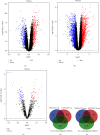Identification of Key MicroRNAs and Genes between Colorectal Adenoma and Colorectal Cancer via Deep Learning on GEO Databases and Bioinformatics
- PMID: 36793496
- PMCID: PMC9922557
- DOI: 10.1155/2023/6457152
Identification of Key MicroRNAs and Genes between Colorectal Adenoma and Colorectal Cancer via Deep Learning on GEO Databases and Bioinformatics
Retraction in
-
Retracted: Identification of Key MicroRNAs and Genes between Colorectal Adenoma and Colorectal Cancer via Deep Learning on GEO Databases and Bioinformatics.Contrast Media Mol Imaging. 2023 Aug 2;2023:9868906. doi: 10.1155/2023/9868906. eCollection 2023. Contrast Media Mol Imaging. 2023. PMID: 37564892 Free PMC article.
Abstract
Background: Deep learning techniques are gaining momentum in medical research. Colorectal adenoma (CRA) is a precancerous lesion that may develop into colorectal cancer (CRC) and its etiology and pathogenesis are unclear. This study aims to identify transcriptome differences between CRA and CRC via deep learning on Gene Expression Omnibus (GEO) databases and bioinformatics in the Chinese population.
Methods: In this study, three microarray datasets from the GEO database were used to identify the differentially expressed genes (DEGs) and differentially expressed miRNAs (DEMs) in CRA and CRC. The FunRich software was performed to predict the targeted mRNAs of DEMs. The targeted mRNAs were overlapped with DEGs to determine the key DEGs. Molecular mechanisms of CRA and CRC were evaluated using enrichment analysis. Cytoscape was used to construct protein-protein interaction (PPI) and miRNA-mRNA regulatory networks. We analyzed the expression of key DEMs and DEGs, their prognosis, and correlation with immune infiltration based on the Kaplan-Meier plotter, UALCAN, and TIMER databases.
Results: A total of 38 DEGs are obtained after the intersection, including 11 upregulated genes and 27 downregulated genes. The DEGs were involved in the pathways, including epithelial-to-mesenchymal transition, sphingolipid metabolism, and intrinsic pathway for apoptosis. The expression of has-miR-34c (P = 0.036), hsa-miR-320a (P = 0.045), and has-miR-338 (P = 0.0063) was correlated with the prognosis of CRC patients. The expression levels of BCL2, PPM1L, ARHGAP44, and PRKACB in CRC tissues were significantly lower than normal tissues (P < 0.001), while the expression levels of TPD52L2 and WNK4 in CRC tissues were significantly higher than normal tissues (P < 0.01). These key genes are significantly associated with the immune infiltration of CRC.
Conclusion: This preliminary study will help identify patients with CRA and early CRC and establish prevention and monitoring strategies to reduce the incidence of CRC.
Copyright © 2023 Xin Zhang et al.
Conflict of interest statement
The authors declare that they have no conflicts of interest.
Figures






Similar articles
-
Identification of MicroRNA-Target Gene-Transcription Factor Regulatory Networks in Colorectal Adenoma Using Microarray Expression Data.Front Genet. 2020 May 19;11:463. doi: 10.3389/fgene.2020.00463. eCollection 2020. Front Genet. 2020. PMID: 32508878 Free PMC article.
-
Identifying the key genes and microRNAs in colorectal cancer liver metastasis by bioinformatics analysis and in vitro experiments.Oncol Rep. 2019 Jan;41(1):279-291. doi: 10.3892/or.2018.6840. Epub 2018 Nov 1. Oncol Rep. 2019. PMID: 30542696 Free PMC article.
-
Employing bioinformatics analysis to identify hub genes and microRNAs involved in colorectal cancer.Med Oncol. 2021 Aug 14;38(9):114. doi: 10.1007/s12032-021-01543-5. Med Oncol. 2021. PMID: 34390411
-
Identification of Key Genes in Colorectal Cancer Regulated by miR-34a.Med Sci Monit. 2017 Dec 3;23:5735-5743. doi: 10.12659/msm.904937. Med Sci Monit. 2017. PMID: 29197895 Free PMC article.
-
Identification and Interaction Analysis of Molecular Markers in Colorectal Cancer by Integrated Bioinformatics Analysis.Med Sci Monit. 2018 Aug 31;24:6059-6069. doi: 10.12659/MSM.910106. Med Sci Monit. 2018. PMID: 30168505 Free PMC article.
Cited by
-
Retracted: Identification of Key MicroRNAs and Genes between Colorectal Adenoma and Colorectal Cancer via Deep Learning on GEO Databases and Bioinformatics.Contrast Media Mol Imaging. 2023 Aug 2;2023:9868906. doi: 10.1155/2023/9868906. eCollection 2023. Contrast Media Mol Imaging. 2023. PMID: 37564892 Free PMC article.
References
-
- Moazzen S., van der Sloot K. W. J., de Bock G. H., Alizadeh B. Z. Systematic review and meta-analysis of diet quality and colorectal cancer risk: is the evidence of sufficient quality to develop recommendations? Critical Reviews in Food Science and Nutrition . 2021;61(16):2773–2782. doi: 10.1080/10408398.2020.1786353. - DOI - PubMed
Publication types
MeSH terms
Substances
LinkOut - more resources
Full Text Sources
Medical
Miscellaneous
